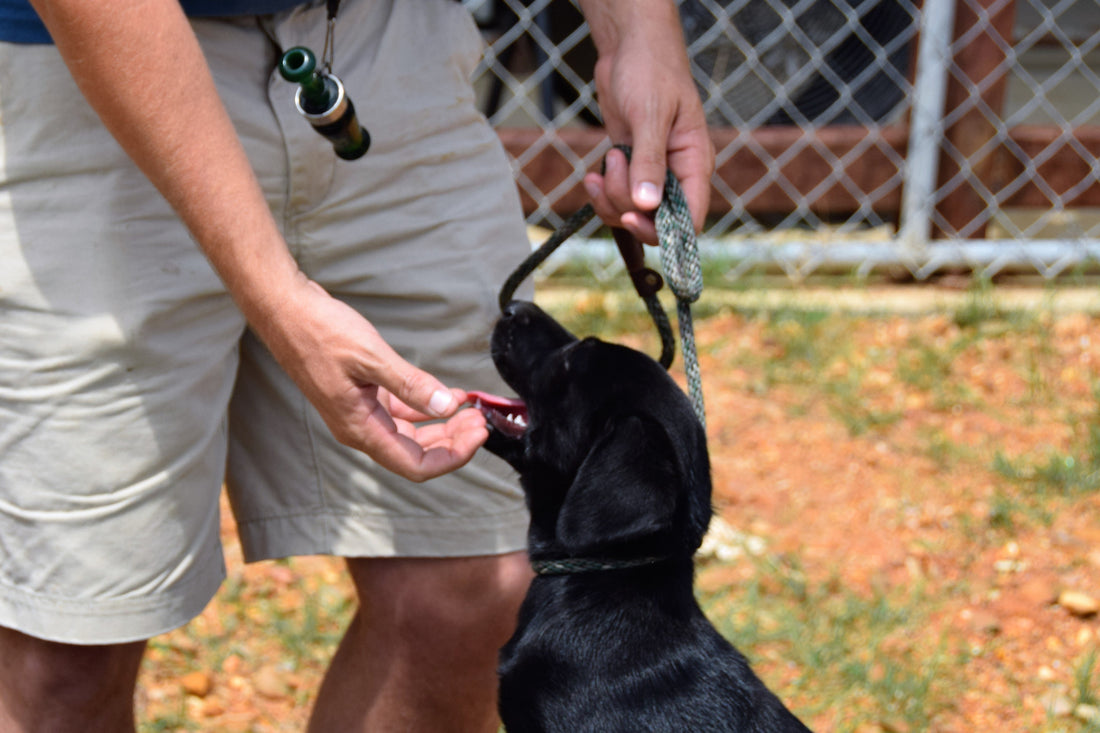What do you mean by simple obedience, and why is it important?
Simple obedience is the core of your dog’s training. It is what allows you to begin to control your dog, and reinforces their view of you as master. It also gives you an opportunity to start introducing your puppy to pressure. What we at Honey Brake refer to as “simple obedience” is a small set of basic commands: sit, here, down, and stay. Simple obedience commands will be used every day of your dog’s life.
How do I get my puppy started on simple obedience?
To get started on simple obedience, you need a leash and collar as well as a few treats. You will also need an area to train in that is relatively free of distractions. Your puppy will learn much faster and be much more responsive to you if you keep its focus. Also to keep your puppy focused, keep training sessions short. Five to ten minutes is plenty of time when you are first starting out, and you can work training sessions up to about twenty minutes once your pup is able to stay focused for longer periods of time.
- Sit- Sit is the first command we teach our puppies at Honey Brake. It is easy for your puppy to master, and easy for anyone to teach. Use treats to get your pup’s attention. When you have its attention, hold the treat at the eye level of the puppy, say “sit”, and begin to slowly raise it in one hand while gently pressing down on the puppy’s rump with the thumb of your other hand. As soon as its rump touches the ground, give your puppy the treat and praise it thoroughly. It is good to introduce a release word at this point. At Honey Brake, we use the word “OK”. Say the release word as you are releasing pressure off of the pup’s rump, and rewarding it with a treat. Repeat this a few times and then repeat the process without using your thumb to press the pup’s rump down. Always make your puppy stay on command until you release it. Once your puppy figures out the command, start to take the treats away so your puppy doesn’t start to defy commands later when there are no treats involved. Remember that your puppy should be following your commands because you are its master.
- Stay- Stay is also a very easy command to teach, and should be taught after your puppy has learned to sit. With your puppy in the sit position and its focus on you, tell it to stay and take a few steps backwards, without losing eye contact. Without overly exciting your puppy, calmly tell it “good stay” as long as it is staying still while you are moving away. After a few seconds, give it its release command and praise it thoroughly and give it a treat. If your puppy moves before you give it the release command, firmly tell it “no” and move it back to the exact spot you want it to stay in. At first, you should only back up a few steps and make it stay for a few seconds. As it gets better and better, you may move further away and extend the time that you make it stay, as well as removing treats from the process. Always remember not to ever let your pup move until you release it, and if it does move, always put it back in the same exact spot you first made it stay in.
- Here- Here is a command that should be taught with a leash and collar, and should follow after your puppy has learned to sit and stay. With the collar on and the leash attached, tell your pup to sit. Walk a few steps away, and then say “here” while holding a treat in your hand out toward the puppy. Use the leash to make sure the puppy comes to you. As soon as the pup gets to you, give it the treat and some praise. Before you start over and let the puppy move away from you, use your release word. Repeat the process a few times and then start over without treats. Once your pup has it figured out, you can start slowly moving farther away. Make sure you do this exercise with a leash attached until you can be sure your pup will follow your command without it on.

As with any other portion of your puppy’s training, always remember to stay calm when things don’t go the way you want and reward your puppy heavily when it does what you want. Your dog should do as commanded the first time you give it a command. With that in mind, don’t give a command if you do not have control over your dog and can not reinforce the command when given. Also make sure that your dog stays on command until you release it. Any little slip can create bad habits. If you follow these tips, simple obedience will be a breeze.
Don’t forget that you can email any of your questions to lyn@honeybrake.com and we will be happy to follow up with you. Our next topic will traveling in a vehicle so be sure to check back next Monday. As always, good luck with your gun dog!


